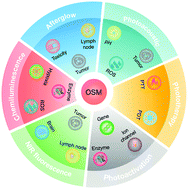Development of organic semiconducting materials for deep-tissue optical imaging, phototherapy and photoactivation
Abstract
Biophotonics as a highly interdisciplinary frontier often requires the assistance of optical agents to control the light pathways in cells, tissues and living organisms for specific biomedical applications. Organic semiconducting materials (OSMs) composed of π-conjugated building blocks as the optically active components have recently emerged as a promising category of biophotonic agents. OSMs possess common features including excellent optical properties, good photostability and biologically benign composition. This review summarizes the recent progress in the development of OSMs based on small-molecule fluorophores, aggregation-induced emission (AIE) dyes and semiconducting oligomer/polymer nanoparticles (SONs/SPNs) for advanced biophotonic applications. OSMs have been exploited as imaging agents to transduce biomolecular interactions into second near-infrared fluorescence, chemiluminescence, afterglow or photoacoustic signals, enabling deep-tissue ultrasensitive imaging of biological tissues, disease biomarkers and physiological indexes. By fine-tuning the molecular structures, OSMs can also convert light energy into cytotoxic free radicals or heat, allowing for effective cancer phototherapy. Due to their instant light response and efficient light-harvesting properties, precise regulation of biological activities using OSMs as remote transducers has been demonstrated for protein ion channels, gene transcription and protein activation. In addition to highlighting OSMs as a multifunctional platform for a wide range of biomedical applications, current challenges and perspectives of OSMs in biophotonics are discussed.



 Please wait while we load your content...
Please wait while we load your content...